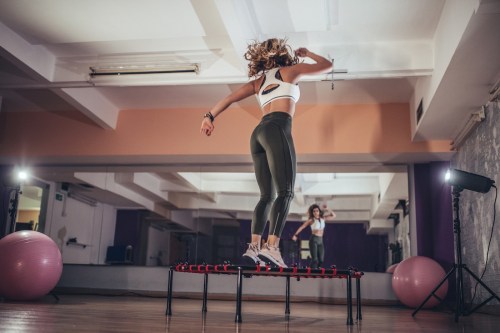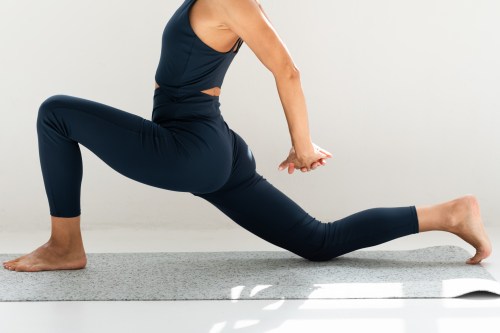List out all of the different types of exercises in the world, and you’d be hard pressed to find one more fun than a rebounder workout. After all, the entire premise is basically just jumping on a trampoline—the way you used to back in third grade—with some choreography mixed in. Rebounding has been around since the early eighties, but has risen in popularity lately thanks to a number of studios like New York City’s The Ness and Los Angeles’s LEKFit integrating trampoline workouts into their class offerings. And for good reason. There are a whole lot of benefits of rebounding (aside from it being one of the most enjoyable ways to break a sweat).
Seriously—a study out of NASA in the eighties (this is when these types of workouts first became popular) found that jumping on a trampoline can give you a full-body workout without the impact and pressure on your ankles and knees that you might get from running on a treadmill. They dubbed it an effective way for astronauts to recover and regain bone and muscle mass after returning from space, and needless to say, if it’s good enough for astronauts, I’ll be all over it. Want to do the same? Here are the benefits and how to incorporate a routine into your sweat mix.
The benefits of rebounding
It gets your heart pumping: The most obvious benefits of rebounding have to do with your cardiovascular system. If you remember anything from fifth grade, you know that bouncing up and down on a trampoline is a great way to get your heart rate up and start sweating. However, rebounding is also a strength-building tool. Not only does the bouncing motion work your lower body and abs (you’ve gotta squeeze that core when you jump, people), but the rebounder itself can be used as a tool to make your other exercises even harder.
It seriously builds strength: “Doing your strength work on the rebounder—for example, with your legs on all fours—forces you to engage your core by preventing yourself from sinking down, much more than you would if you were doing the same exercise on the floor using a mat,” says Lauren Kleban, founder of LEKFIT. “The rebounder is also much more comfortable on your knees than being on the floor.” In Kleban’s class, students are instructed to use theirs as a ballet barre during a standing leg series.
At The Ness, it’s used in lieu of a mat for certain abs, glutes, and arms moves. “The instability that the rebounder provides helps intensify these types of moves, making them a lot harder. One of my favorite stabilization exercises is single leg deadlift on the trampoline,” says Giampolo, explaining that you balance with one foot on the trampoline while your other leg shifts back and you send the crown of your head forward. Because the trampoline mat is soft, balancing on it is hard to begin with. “By adding this motion, you’re working the backs of your legs and your core is working double-time to keep you from falling over,” she says. In other words: You will definitely be feeling it the next day.
It helps the lymphatic system: “Bounce is more effective than other workouts for lymphatic drainage because of the effects of gravity and your body’s muscle contractions while on the trampoline,” says Giampolo. “You can achieve movements that you wouldn’t otherwise be able to without bouncing, which increases circulation of these lymph fluids.” Taryn Toomey, founder of The Class, echoes these sentiments. “The beautiful thing about rebounding is that it gives your lymphatic system a boost,” she says. “The lymphatic system doesn’t have a track like your blood does. So the way to engage it is through rebound, massage, or any form of movement that creates a vibration or pressure into the tissues and body.”
It builds pelvic floor strength: And one more (rather unexpected) benefit of rebounding? It can actually help with your pelvic floor strength. “There is also little to no impact when jumping on a rebounder and it is extremely beneficial for our pelvic floors; each time you land on the rebounder, the body is forced to pull up,” says Kleban, adding that she’s seen many postpartum women regain bladder control (an issue that effects more than 20 percent of postpartum women) after integrating rebounding workouts into their post-baby routines.
How to reap the max benefits
In order to get the most out of your rebounding workout, you want to make sure you’re using the trampoline the right way… which is slightly different than what you were probably accustomed to when you were attempting backflips in your best friend Lily’s backyard. “You want to focus on jumping down instead of up—this isn’t about getting ‘air’ like when we were kids, it’s about control through your core while activating the glutes, hamstrings and inner thighs,” says Kleban. “You’re working from head to toe so focus and proper form are key. We instruct everyone to remain center on their rebounder, lifting up to elongate the spine and to use their arms.” Think about bouncing down instead of up, or as Giampolo puts it, “body low, knees up.” In other words, “For almost every movement on the trampoline, proper form consists of keeping your knees soft with weight driving down through your heels, using your lower abdominal muscles to pull your knees towards your center with every bounce.”
To get the benefits of rebounding on your own (ya know, if buying a rebounder for your living room is something that floats your boat), try one of these three moves, care of Giampolo.
1. Bounce down: Bounce down lays the groundwork for most moves on the trampoline. Your upper body maintains a squat posture while your heels push down into the trampoline and your core pulls your knees up towards your chest.
2. Ski: Using the same mechanics as a bounce down, you squeeze your inner thighs tight, lifting your knees and shooting your hips to jump from side to side on the trampoline while your arms swing up and down one at a time.
3. Scissor: Keeping your weight in your heels, you switch your feet evenly with one foot in front of the other while driving your elbows back.
Or, if you’re more of a visual rebound learner, follow along with this full routine from Body by Simone’s Simone de la Rue:
No matter what type of workout you’re doing, here’s how to have good form when you’re exercising alone. And once you’re done working those muscles, stretch ’em out with this hamstring move that will make your legs feel like buttah butter.
Sign Up for Our Daily Newsletter
Get all the latest in wellness, trends, food, fitness, beauty, and more delivered right to your inbox.
Got it, you've been added to our email list.










